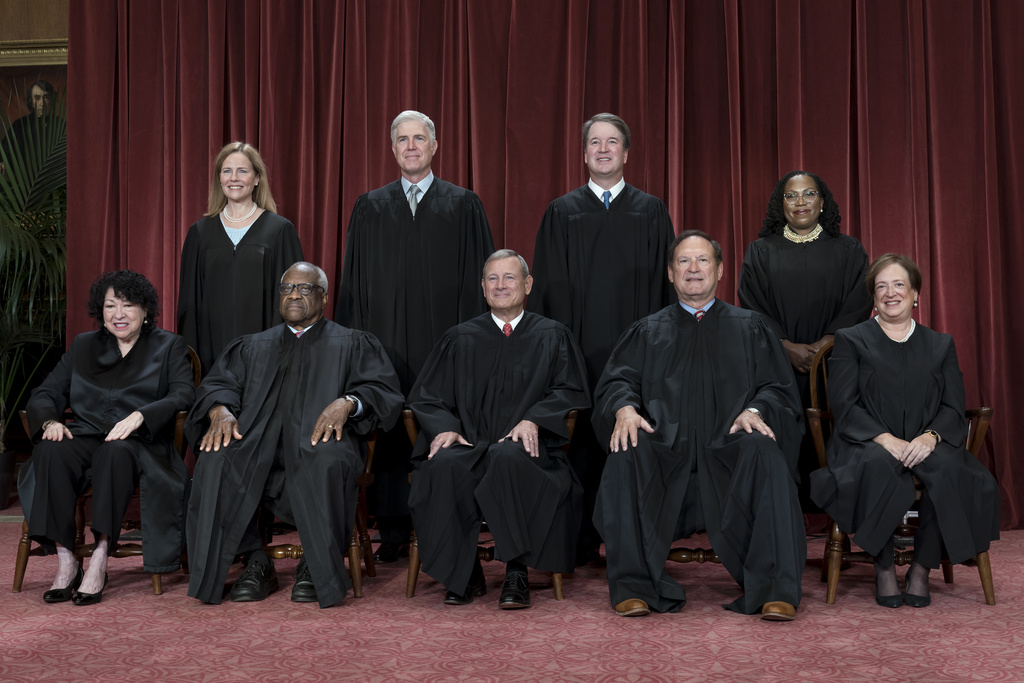Justice Brett Kavanaugh pointed to the mixed U.S. Supreme Court decisions this term as he sought Thursday to dispel notions that it is partisan, even after conservatives brought about the end of affirmative action in college admissions and struck down President Joe Biden’s student loan debt relief program.
“The court is an institution of law. It’s an institution of law not of politics, not of partisanship,” Kavanaugh said at a judicial conference in Minnesota, in the first public remarks by a justice since the court recessed for the summer late last month.
The Supreme Court has been reshaped by the three justices nominated by President Donald Trump, including Kavanaugh. Although Kavanaugh sided with the conservative majorities in the affirmative action and student loan rulings, as well as last summer’s ruling overturning the nationwide right to abortion, he was also part of the mixed conservative and liberal majorities this term that backed Black voters in Alabama and preserved a federal law aimed at keeping Native American children with Native families.
And the term was marked by other notable surprises, rejecting conservative positions in a North Carolina redistricting case that could have reshaped elections across the country, while backing the Biden administration in a fight over deportation priorities.
“We have lived up, in my estimation, to deciding cases based on law and not based on partisan affiliation and partisanship,” Kavanaugh said. “We don’t caucus in separate rooms. We don’t meet separately. We’re not sitting on different sides of the aisle at an oral argument. … We work as a group of nine.”
Speaking to an audience of judges, attorneys and court personnel from the 8th Circuit, which stretches from Minnesota and the Dakotas south to Arkansas, Kavanaugh said he didn’t fully appreciate until he joined the court how much time the nine justices spend alone with each other.
He estimated that they eat lunch together around 65 times a year.
“And the rule at lunch is you can’t talk about work,” he said. “It’s a good rule. … It builds relationships and friendships and then when we have tough cases — and we only really have tough cases — you have a reservoir of good will toward each of the other people.”
Kavanaugh said he was warmly welcomed in his first term in 2018 by then-Justices Ruth Bader Ginsburg and Stephen Breyer, who were part of the court’s liberal wing. He also praised his working relationships with the two newest justices, conservative Amy Coney Barrett and liberal Ketanji Brown Jackson.
Kavanaugh, who was the justice most often in the majority this term in divided cases, said the Supreme Court hears 60 to 70 cases a term and that only a relative few might get most of the attention. But he said there are lots of 9-0 decisions, and there can also be a lot of 7-2 and 6-3 decisions.
“All sorts of different lineups,” he said. “And so I might be working with Sonia Sotomayor on the Andy Warhol case, while we disagree on a case on the competition clause. We’re not going to let our relationship where we’re working together on one suffer just because we disagree on the other. And that’s going on with all nine of us on a daily basis.”
Kavanaugh only briefly mentioned the ethics issues that have dogged some justices — including conservatives Clarence Thomas and Samuel Alito and the liberal Sotomayor — and potentially undermined public confidence in the court. He noted that Chief Justice John Roberts said in May that the justices were continuing to work on that as a group.
“That’s accurate,” he said. “I’m not going to add anything to what the chief justice has said on that topic.”
Roberts offered no specifics at the time, and the justices have not adopted an ethics code.
Kavanaugh said people getting upset when the high court makes difficult decisions comes with the territory. He said the best the justices can do is try to be consistent, clearly explain their reasoning, and try to show that they actually are working as a team of nine on difficult cases instead of caucusing on a partisan basis.
“You shouldn’t be in this line of work if you don’t like criticism,” he said. “Because you’re going to get it. And you’re going to get a lot of it.”
(AP)












2 Responses
“Originalism” (basing an interpretation of a law on how it was understood when enacted) and “Textualism” (focusing on what the law actually says, regardless of intent”) are not inherently “conservative” or “Republican”, and more than “Living constitution” (focusing on current conditions and trying to ask what would the authors of a law say if they were alive today with current knowledge, and by implication, with the current judge’s biases) is “liberal” or “Democratic”.
For example, some the “worst” decisions reflecting “Living constitution” (and rejecting “originalism” or “textualism”) were the decision in “Dred Scott”, “Plessy v. Ferguson”, not to mention “Roe v Wade”.
What non-lawyers focus on is what happens in the real world, but that isn’t necessary what the Supreme Court Justices are thinking, since the often more concerned with legal principles than political results.
All I get from his statement is that he likes beer.